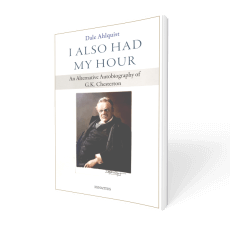Dale Ahlquist introduces readers to the man behind the writings.
Knight of the Holy Ghost
Who was Gilbert Keith Chesterton? A rotund man in a cape brandishing a walking stick? Certainly. A twentieth-century writer? Prolifically. A great champion and defender of the Christian Faith? Gallantly. He is known too as the “prince of paradox” and an “apostle of common sense.” Chesterton has lately been enjoying a resurgence in popularity. His name appears on blog posts and news articles alike. His name is spoken more often on college campuses, and schools around the United States are being named after him. Who was this engaging, witty, prophetic man? Allow Dale Ahlquist, the president of the American Chesterton Society, to introduce you to him. In a rollicking adventure quite Chestertonian in flavor, Ahlquist captains an expedition of discovery into who this GKC fellow is. He deftly and cleverly explores Chesterton as a man, as a writer, and as a potential saint.
Those curious about Chesterton will have their initial questions answered. Those who might be dubious about Chesterton’s reputation will be challenged to reconsider. Those who consider Chesterton an old friend will be delighted. All will be engaged by amusing anecdotes, plentiful quotations, and a thoughtful study of the life of G.K. Chesterton.
I Also Had My Hour: An Alternative Autobiography of G.K. Chesterton
Nearly a century after his death, G. K. Chesterton comes out with a new book . . . about himself!
Renowned Chesterton scholar Dale Ahlquist presents a unique retelling of Chesterton’s life in Chesterton’s own words, drawn from hundreds of sources—including material that has not been seen for over a hundred years—and edited into a narrative. Ahlquist has used bits and pieces, sentences and paragraphs, even poems, to allow the Prince of Paradox, while talking about something else, to give many revealing glimpses of himself. Although Chesterton penned an autobiography at the end of his life, he mostly wrote about other people. Here, finally, is the person he neglected to tell us about: G. K. Chesterton.
Ahlquist’s careful compilation yields a new, intimate look at the most interesting character in Chesterton’s story: the man holding the pen. We learn about his youth, his beginnings as a writer, his rise as a literary star, his family and friends and foes, his travels, his struggles and temptations, his controversies, his sorting out the mystery of life, and his conversion to the Catholic faith.
For many readers, even those familiar with Chesterton, much of the material in this book will be completely new. Ahlquist also provides an extensive timeline of Chesterton’s life, which is itself a compact biography.
BONUS ADD-ON: The Woman Who Was Chesterton
The Woman Who Was Chesterton is a love story. But it is also a detective story. And best of all, it is a true story, told here for the the first time. Gilbert Keith Chesterton was a romantic, a writer of detective tales, and a teller of the truth. His own story and the stories he told are becoming better and better known. But what has remained unknown is the story of the most important person in his life: his wife Frances Chesterton.
Nancy Carpentier Brown has done incredible detective work to uncover the mystery of Frances, tracking a figure who managed to leave very few traces of herself.
It is quite likely that as more is discovered about Frances, more biographies will be written of her, and they will be even more complete. But they will all come back to this one: The Woman Who Was Chesterton.





